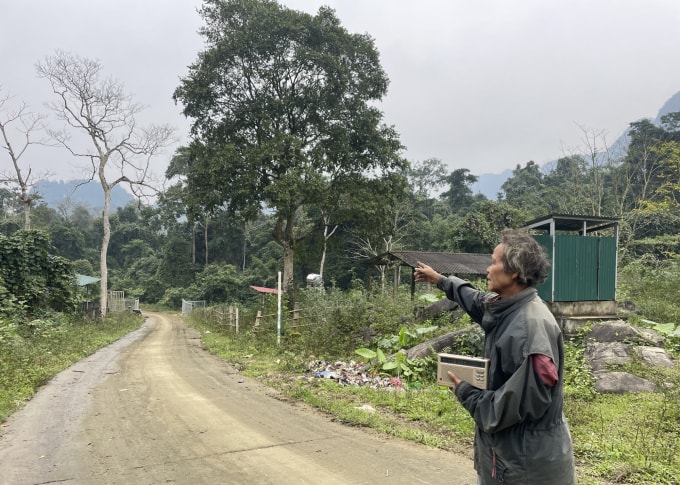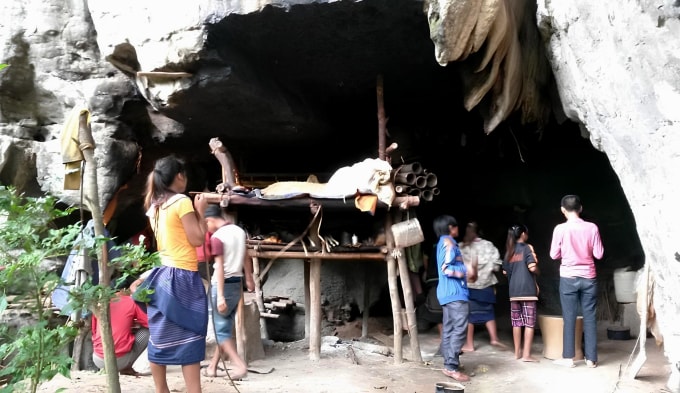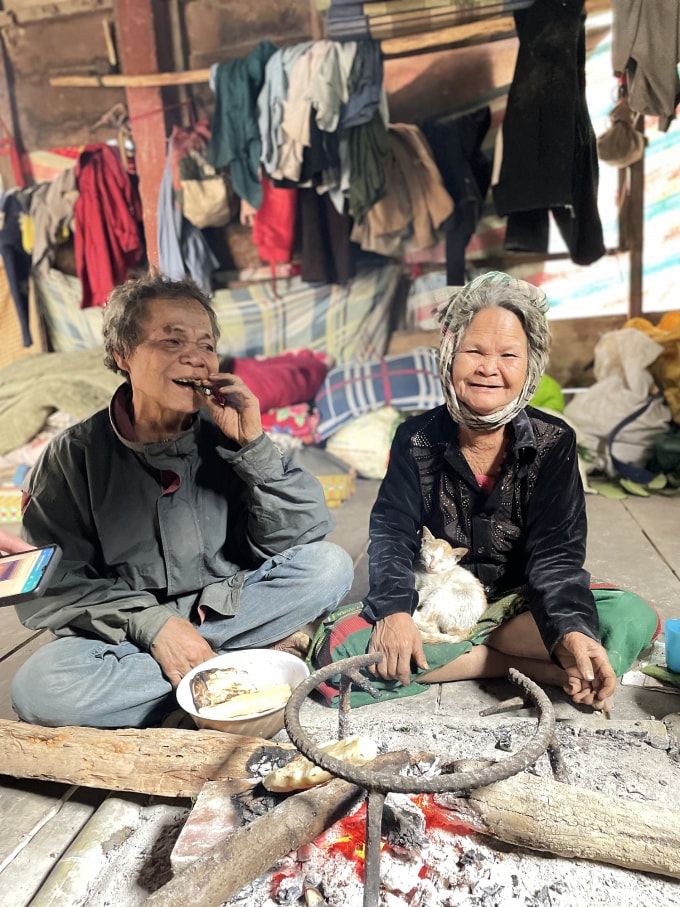The huts and cave houses on the mountains of Phong Nha - Ke Bang National Park (Quang Binh) are where Mr. Dinh Ne, 91 years old, and his wife, Mrs. Y Ru, 93 years old, are living.

On the mountains of Phong Nha - Ke Bang National Park (Quang Binh), every few kilometers there are huts and houses in caves.
That is not a vestige of the primitive life of the Arem people in the past, but the place where Mr. Dinh Ne, 91 years old, and his wife, Mrs. Y Ru, 93 years old, are living.
In recent years, the couple has mainly stayed in Chim Cave, a 2-hour walk from Tan Trach village, Bo Trach district. Outside, hunting and gathering tools hang from the cliffs. Deeper into the cave, a dim light shines on a bamboo bed built high up, where the couple sleeps to avoid wild animals. Below the cave entrance are small fields where they grow vegetables and fruits. A babbling stream flows across, convenient for daily activities.
"In March, when the weather is warm and sunny, I will return to the forest," Mr. Dinh Ne said in Arem while he and his wife were in their house in Tan Trach settlement.
Mr. Dinh Ne and his wife do not remember exactly how long the Arem have lived in the cave. They only know that they saw their adoptive parents growing up there when they were children. "Whenever they saw bombs and bullets from war, the Arem ran away and hid deeper into the forest," said the 91-year-old man.
In 1956, the Arem people were discovered by the Quang Binh border guards in steep and dangerous limestone caves such as Va cave, Bong Cu cave, and So Dua cave in Bo Trach district. They lived a primitive life, wearing clothes made from tree bark, hunting, gathering, and eating without cooking.
When the war ended, the government brought them back to settle in their villages. However, the habit of living close to the forest made it difficult for the Arem to adapt. Every time an epidemic or an incident happened, they thought "the forest god was angry" and left their village. It was not until 2004 that they were able to completely abandon the caves after the government built them a solid village.
Mr. Ne himself still had difficulty adapting to the new lifestyle. During his healthy years, he and his wife could hardly leave the mountains and forests, only occasionally returning to the village to get rice and salt. When their health was almost gone, their time in the village was extended, but from March to October every year they would go into the cave together, only returning home once every few weeks.

In the forest, they built dozens of huts along the Ruc Ca Roong stream. Every day, Mr. Ne went down to the stream to catch fish, and Mrs. Ru guarded the fields from wild pigs. "In the forest, there is delicious food, fish and shrimp come out, and bamboo shoots grow in abundance. At home, there is only rice with salt mixed with chili," said Mrs. Y Ru.
Having lived in the forest all their lives, they found life there more comfortable and safer. They knew many medicinal plants or edible starch plants. In addition to using nets, traps, and traps, they also used crushed leaves of the do ho tree, dropped them into the stream so that the fish would absorb the poison and float up, and then just scoop them up.
Mr. Dinh Ne is Mrs. Y Ru's brother-in-law. One lost his wife and the other lost her husband many years ago. According to the custom of "connecting the strings", they came to live together. Mrs. Y Ru said that this winter her legs hurt and she had difficulty walking, but every day when she woke up her husband invited her back to the forest.
"He still climbs mountains, crossing steep rocks so fast that young people have difficulty keeping up," she said. "When he was young, he was famous for his strength because he could carry 1.5 quintals of wood."
According to Mr. Nguyen Van Dai, Secretary of Tan Trach Commune, over the years Mr. Ne has built his house in dozens of caves and huts along the Ruc Ca Roong stream. During the day, he stays in the hut near the stream to find food. At night, when there are floods or when there is a lot of food, he brings it back to the cave.
"A few years ago, we had to send young people into the forest to find Mr. Ne and bring him back to make a citizen identification card," said Mr. Dai.
Mr. Ne's son, Mr. Dinh Hoe, also said that his parents' health is now weak, so their children and grandchildren do not allow them to go. In July, his joints were swollen and applying forest leaves did not help. After a long time, his children and grandchildren went to look for him and mobilized people to carry him home on a stretcher.
After a few days at the clinic, his legs missed the forest again. In September, the floodwaters at Ruc Ca Roong stream rose to the foot of the mountain, completely isolating the cave where he and his wife were living. For several days, Mr. Ne could only sit in the cave, eating cassava to survive.
"At that time, my grandparents' grandchildren and I had to carry rice on our heads and swim across the fast-flowing stream to deliver supplies," said Dinh Chai, Vice Chairman of the People's Committee of Tan Trach Commune, the first Arem person to have a university degree.
According to Chai, Mr. and Mrs. Dinh Ne have a strong love for the mountains and forests, but other Arem people also like to live in the forest. In the summer, families gather together to build huts in the flower forest, the area where they used to live. By the Ruc Ca Roong stream, they can freely bathe, catch fish, and pick fruits to eat. When night falls, every family gathers around a fire by the stream, drinking wine and singing.

From an ethnic group with 18 people discovered in 1956, the Arem community in Tan Trach village has now grown to 66 households with 188 people. Concrete roads leading to homes, electricity and internet coverage, and spacious offices have brought about great changes for the "latest discovered ethnic group in Vietnam".
However, according to Mr. Nguyen Van Dai, people's lives are still very difficult. Because it is located in the core area of Phong Nha - Ke Bang National Park, the land for production is limited and cannot be expanded. In addition, farming depends entirely on nature, rudimentary farming tools, and many wild animals destroy, so economic efficiency is low.
In recent years, the government, agencies, organizations and businesses have paid much attention to the lives of the people. Households here are given the opportunity to protect the forest and are paid an average of 25 million VND per household per year.
"The basic support is enough to cover 9-10 months of the year, but due to limited awareness, people do not know how to save and calculate their income, so they are still hungry," said Mr. Dai. 80% of households in the village are still poor.
Although modern life has crept into every roof, for Mr. Dinh Ne, the forest is still everything. In their village house, besides old clothes, there are several cold pots. Next to the pot of half-eaten rice is a pot of bamboo shoots that Mr. Ne collected the day before and a pot of cassava that is as hard as rock, no one knows when it was boiled.
"I'm old, my legs hurt so I can't go to the forest anymore. As for him, he will probably still go," Mrs. Y Ru looked at her husband and shared.
But Mr. Ne sighed and said his children would not let him go. "I'm afraid I won't have money to give them if I have to carry them back," he said.
TB (according to VnExpress)